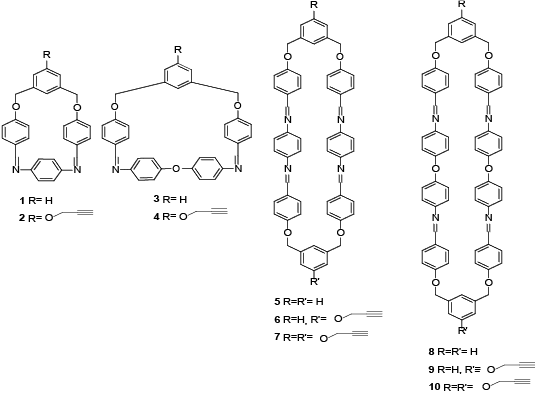
Figure 1: Structure of iminophanes 1-10

Mani Jayanthi Perumal Rajakumar*
Department of Organic Chemistry, University of Madras Guindy, Chennai, India*Corresponding author: Perumal Rajakumar, Professor & Head, Department of Organic Chemistry, University of Madras Guindy, Chennai, India, Tel: 91-044-22202815; 91-044-22202810; E-mail: perumalrajakumar@gmail.com
Bi and tetra dendate cyclophanes with imine and ether linkages were synthesized in good yields by O-alkylation and imine bond formation. All the synthesized cyclophanes/iminophanes exhibits better in-vitro antioxidant properties by DPPH method.
Cyclophanes; Schiff’s base; Antioxidant; Free radical scavenging
Cyclophanes [1,2] have become important in host-guest chemistry as well as in supramolecular chemistry as they constitute host compounds for guest particles because of their cavities. Cyclophanes usually are not at all planar molecules; they exhibit an interesting stereochemistry ; molecular parts are placed and sometimes fixed in unusual orientations toward each other, and often the molecules are not rigid [3,4] but flexible. Ring strain and, as a consequence, deformation of the benzene rings out of planarity are often encountered. The most promising biological activities of Schiff bases [5] and their chelating property attracts the chemists to synthesize Schiff ’s base cyclophanes [6].
Compounds with imine functionality (viz., Schiff ’s base) are well known for their importance in photochromic field and shows biological activity such as bacteriostatic, bactericidal in vivo biological activity such as antitumor, anti-viral. Further, medical research has proved that, the biological oxygen free radicals in the body (including superoxide anion radical) produce excessive or clear block, which will lead to a variety of diseases such as inflammation, aging and cancer. Certain amino acid Schiff base has a clear role of superoxide ions, and thus plays the role of anti-viral. The most promising biological activities of Schiff bases [5] and their chelating property has attracted the synthetic chemists to synthesize Schiff ’s base based cyclophanes [6]. Herein the authors report the synthesis and invitro anti-oxidant properties of cyclophanes 1-10 (Figure 1).
All melting points are uncorrected. The 1 H NMR and 13C NMR spectra were recorded on Bruker 300-MHz instrument in CDCl3 solvent with tetramethylsilane (TMS) as an internal reference. Elemental analyses were carried out on a Perkin-Elmer CHNS 2400 instrument. Column chromatography was performed on silica gel (ACME, 100–200 mesh). Routine monitoring of the reaction was made using thin-layer chromatography (TLC) developed on 0.25 mm glass plates coated with silica gel-G (ACME) and visualized with iodine.
To a solution of the dialdehyde (2.3 g, 1.21 mmol) in ethanol was added the diamino compound (1.23 mmol/2.46 mmol) in ethanol in the presence of catalytic quantity of acetic acid and molecular sieves 4 °A and refluxed for 6 h. The reaction mixture was then filtered, evaporated and washed with CHCl3 : hexane solvent mixture.

Figure 1: Structure of iminophanes 1-10
Orange solid; Yield: 68%; M. Pt: 101-103°C; 1 H NMR: (300 MHz, CDCl3 ) δH 5.11 (s, 4H), 6.21-6.25 (br, 4H), 6.62-6.64 (m, 4H), 7.04-7.09 (m, 4H), 7.36-7.82 (m, 8H), 8.64-8.67 (m, 2H); 13C NMR: (75 MHz, CDCl3 ): δC 70.9,114.1,114.4,123.1,125.7,128.7,129.0,130.2,142.1,141.7,14 6.7,160.0,161.3.
Orange solid; Yield: 64%; M. Pt: 102-105°C; 1 H NMR: (300 MHz, CDCl3 ) δH 3.21-3.24 (m, 1H), 4.42-4.45 (m, 2H), 5.09 (s, 4H), 6.21-6.27 (br, 4H), 6.61-6.64 (m, 4H), 6.89 (s, 1H), 7.01-7.03 (m, 6H), 7.32-7.38 (m, 4H), 7.81-7.84 (m, 4H), 8.62-8.63 (m, 2H); 13C NMR: (75 MHz, CDCl3 ): δC 59.9,75.2,77.3,114.1, 114.5,117.1,123.4,126.7,130.1,142.1,145.7,159.9,161.5.
Orange solid; Yield: 62%; M. Pt: 113-115°C; 1 H NMR: (300 MHz, CDCl3 ) δH 5.18 (s, 4H), 6.19-6.23 (br, 4H), 6.69-6.78 (m, 8H), 7.01-7.03 (m, 4H), 7.21-7.25 (m, 4H), 7.34 (s, 1H), 7.43-7.49 (m, 2H), 7.79-7.83 (m, 4H), 8.59-8.62 (s, 2H); 13C NMR: (75 MHz, CDCl3 ): δC 70.9,114.3,116.3,11 9.8,120.3,121.4,129.8, 131.4,143.2,144.2,151.4, 159.9,161.4.
Orange solid; Yield: 61%; M. Pt: 118-121°C; 1 H NMR: (300 MHz, CDCl3 ) δH 3.19-3.24 (m, 1H), 4.39-4.42 (m, 2H), 5.16 (s, 4H), 5.89-6.03 (m, 4H),6.63-6.71 (m, 8H), 6.78-7.01 (m, 4H), 7.03-7.07 (m, 4H), 7.18- 7.22 (m, 4H), 7.29 (s, 1H), 7.38-7.41 (m, 2H), 7.67-7.71 (m, 4H), 8.57-8.61 (m, 2H); 13C NMR: (75 MHz, CDCl3 ): δC 58.7,74.9,76.6,113.8,114.2,119.8, 121.4,125.4,130.1,141.8,152.4,159.8,161.4.
Orange solid; Yield: 64% ; M. Pt : 132-135°C; 1 H NMR: (300 MHz, CDCl3 ) δH 5.09 (s, 4H), 6.88-6.99 (m, 4H), 7.10-7.13 (m, 4H), 7.39-7.45 (m, 3H), 7.48 (s, 3H), 7.86-7.87 (m, 1H), 8.68 (s, 2H); 13C NMR: (75 MHz, CDCl3 ): δC 70.1,111.6,116.7,119.0,121.4,123.4,131.2,132.4,145.1 ,159.7,165.4.
Pale yellow solid; Yield: 62%; M. Pt: 128-130°C; 1 H NMR: (300 MHz, CDCl3 ) δH 3.23-3.26 (m, 1H), 4.48-4.52 (m, 2H), 5.12 (s, 4H), 6.78-6.82 (m, 4H), 7.15-7.18 (m, 4H), 7.39-7.47 (m, 3H), 7.49 (s, 3H), 7.88-7.91 (m, 1H), 8.65 (s, 2H); 13C NMR: (75 MHz, CDCl3 ): δC 59.7,75.4,77.8, 69.1,111.6,116.7,118.8, 121.2,123.4,131.1,132.6,144.6,158.9,165.8.
Pale yellow solid; Yield: 58%; M. Pt: 132-135°C; 1 H NMR : (300 MHz, CDCl3 ) δH 5.11 (s, 4H), 6.31-6.36 (m, 4H), 6.42-6.54 (m, 3H), 6.61-6.73 (m, 2H), 6.78-7.11 (m, 2H), 7.24-7.27 (m, 1H), 7.78-7.85 (m, 3H), 7.89- 7.95 (m, 3H), 8.11-8.27 (m, 2H), 8.31 (s, 2H); 13C NMR: (75 MHz, CDCl3 ): δC 69.9,112.1,113.2, 116.7,119.0,121.2,123.2,131.4,132.1,143.2,159.4,165.2.
Pale yellow solid; Yield: 55%; M. Pt: 128-131°C; 1 H NMR: (300 MHz, CDCl3 ) δH 3.28-3.31 (m, 1H), 4.47-4.49 (m, 2H), 5.20 (s, 4H), 6.37-6.40 (m, 4H), 6.41-6.49 (m, 3H), 6.61-6.78 (m, 2H), 6.79-7.14 (m, 2H), 7.24- 7.29 (m, 1H), 7.75-7.87 (m, 3H), 7.89-7.93 (m, 3H), 8.14-8.29 (m, 2H), 8.35 (s, 2H); 13C NMR:(75 MHz, CDCl3 ): δC 56.8,69.9,75.4,77.6,111.8,113. 2,116.8,119.0,121.2,123.4,131.6,132.1,143.5, 159.4,165.2.
Off-white solid; Yield: 53% ; M. Pt: 142-145°C; 1 H NMR : (300 MHz, CDCl3 ) δH 5.28 (s, 8H), 6.64-6.71 (m, 4H), 7.24-2.29 (m, 4H), 7.34-7.42 (m, 4H), 7.75-7.88 (m, 6H), 7.89-7.93 (m, 6H), 8.22-8.28 (m, 6H), 8.35 (s, 4H); 13C NMR:(75 MHz, CDCl3 ): δC 70.3,111.8,113.2,116.8,119.0,121.2,12 3.4,130.8,132.1,142.6, 159.7,162.3,165.4.
Off-white solid; Yield: 52% ; M. Pt: 123-125°C; 1 H NMR : (300 MHz, CDCl3 ) δH 3.23-3.28 (m, 1H), 4.38-4.42 (m, 2H), 5.20 (s, 8H), 6.58-6.65 (m, 8H), 7.28-7.34 (m, 9H), 7.82-7.87 (m, 8H), 8.14-8.29 (m, 6H), 8.34 (s, 4H); 13C NMR:(75 MHz, CDCl3 ): δC 56.8,69.9,74.8,77.4,111.6,113.2,116.7, 118.8,121.2,123.4, 132.1,132.1,144.5,157.8,163.8.
Yield: 54% ; 1 H NMR : (300 MHz, CDCl3 ) δH 3.20-3.26 (m, 2H), 4.31- 4.37 (m, 4H), 5.23 (s, 8H), 6.68-6.72 (m, 6H), 7.23-7.30 (m, 9H), 7.78-7.82 (m, 8H), 8.11-8.20 (m, 7H), 8.37 (s, 4H); 13C NMR:(75 MHz, CDCl3 ): δC 57.0,70.1,75.3,78.2,111.3,112.2,116.7,117.8,120.8,123.4,131.8,132.1,144.5, 157.8,165.8.
Yield: 55% ; 1 H NMR : (300 MHz, CDCl3 ) δH 5.20 (s, 8H), 6.58-6.67 (m, 12H), 7.21-7.30 (m, 11H), 7.72-7.78 (m, 9H), 8.11-8.21 (m, 8H), 8.38 (s, 4H); 13C NMR:(75 MHz, CDCl3 ): δC 69.8,111.2,112.8,116.7, 117.9,121.2,1 23.4,132.1,143.8,154.7,164.2.
Yield: 50%; 1 H NMR : (300 MHz, CDCl3 ) δH 3.25-3.32 (m, 2H), 4.36- 4.42 (m, 4H), 5.23 (s, 8H), 6.76-6.82 (m, 11H), 7.31-7.43 (m, 12H), 7.80- 7.86 (m, 8H), 8.11-8.19 (m, 8H), 8.39 (s, 4H); 13C NMR:(75 MHz, CDCl3 ): δC 56.8,70.5,75.6, 77.9,110.8,112.2,117.2,118.2,120.8,123.4,131.8,132.1,14 3.8,155.7,163.7.
Yield: 54%; 1 H NMR: (300 MHz, CDCl3 ) δH 3.20-3.26 (m, 2H), 4.31- 4.37 (m, 4H), 5.27 (s, 8H), 6.68-6.72 (m, 9H), 7.23-7.30 (m, 11H), 7.78- 7.82 (m, 12H), 8.11-8.20 (m, 7H), 8.37 (s, 4H); 13C NMR:(75 MHz, CDCl3 ): δC 57.0, 69.8, 75.3,77.82,111.3,111.8,116.7,117.8,121.2,123.4,130. 8,131.7,144.5,157.8,165.8.
Isophtahlic acid 11/5-hydroxyisophthalic acid 12 when subjected to esterification with ethanol afforded diethyl isophthalate 13/diethyl 5-hydroxy isophthalate 14 as colourless liquid/white solid respectively (Scheme 1). In the 1H NMR spectrum 13 displayed the methylene protons at δ 5.13 in addition to the signals for the other aromatic protons from δ 6.31 to δ 7.56. In 13C NMR spectrum 13, the methylene carbon appeared at δ 67.3 in addition to signals for the other aromatic carbons. In the 1H NMR spectrum, 14 displayed the methylene protons at δ 5.13 in addition to the signals for the other aromatic protons from δ 6.31 to δ 7.56. In 13C NMR spectrum of 14, the methylene carbon appeared at δ 67.3 in addition to signals for the other aromatic carbons.
Diethyl 5-hydroxy isophthalate 14 was reacted with propargyl bromide to give the corresponding propargylated diester 15 (Scheme 1). In the 1H NMR spectrum of 15 displayed the methylene protons at δ 5.13 in addition to the signals for the other aromatic protons from δ 6.31 to δ 7.56. In 13C NMR spectrum of cyclophane 15 the methylene carbon appeared at δ 67.3 in addition to signals for the other aromatic carbons.
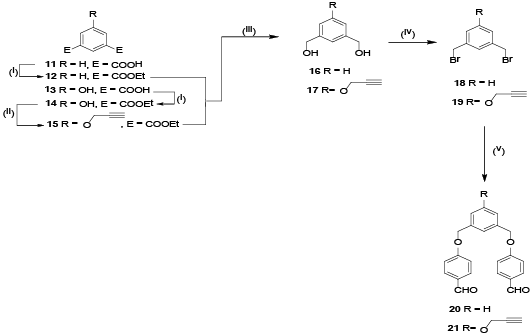
Scheme 1: Reagents and Conditions: (i) EtOH, Reflux, 8 h, 12 (97%), 14 (96 %) (ii) Propargyl bromide (1.25 equiv), K2CO3, DMF, 60°C, 24 h, 15 (91%) (iii) LAH (2.2 eq), THF, 0°C-RT, 24 h, 16 (76%), 17 (77%) (iii) PBr3 (2.1 eq), CHCl3, RT, 18 (85%), 19 (84%) (iv) 4-Hydroxy benzaldehyde (2.1 eq), K2CO3, DMF, 50°C, 24 h, 20 (73%), 21 (72%)
The diesters 13 and 15 were then reduced by LAH12 to afford the corresponding dihydroxy compounds 16 and 17 respectively followed by bromination with PBr3 to afford the corresponding dibromo compounds 18 and 19 respectively in good yields (Scheme 1). In the 1H NMR spectrum 16 displayed the methylene protons at δ 5.13 in addition to the signals for the other aromatic protons from δ 6.31 to δ 7.56. In 13C NMR spectrum 16 the methylene carbon appeared at δ 67.3 in addition to signals for the other aromatic carbons. In the 1H NMR spectrum 17 displayed the methylene protons at δ 5.13 in addition to the signals for the other aromatic protons from δ 6.31 to δ 7.56. In 13C NMR spectrum 17 the methylene carbon appeared at δ 67.3 in addition to signals for the other aromatic carbons.
In the 1H NMR spectrum 18 displayed the methylene protons at δ 5.13 in addition to the signals for the other aromatic protons from δ 6.31 to δ 7.56. In 13C NMR spectrum 18 the methylene carbon appeared at δ 67.3 in addition to signals for the other aromatic carbons. In the 1H NMR spectrum 19 displayed the methylene protons at δ 5.13 in addition to the signals for the other aromatic protons from δ 6.31 to δ 7.56. In 13C NMR spectrum 19 the methylene carbon appeared at δ 67.3 in addition to signals for the other aromatic carbons.
The dibromides 18 and 19 were then treated with 4-hydroxy benzaldehyde in dry DMF in the presence of K2CO3 to give the dialdehydes 20 and 21 respectively in good yields (Scheme 1). In the 1H NMR spectrum 20 displayed the methylene protons at δ 5.17 in addition to the signals for the other aromatic protons from δ 7.06 to δ 9.88. In 13C NMR spectrum 20 the methylene carbon appeared at δ 70.0 and the carbonyl carbon appeared at δ 190.8 in addition to signals for the other aromatic carbons. In the 1H NMR spectrum 21 displayed the methyne proton at 2.55 and the two distinct O-methylene protons at δ 4.72, 5.16 respectively in addition to the signals for the other aromatic protons from δ 7.03 to δ 9.89. In 13C NMR spectrum 21 the methyne carbon appeared at δ 55.9 and the two distinct O-methylene carbons appeared at δ 69.8, 75.9 respectively in addition to signals for the other aromatic carbons.
To a solution of the dialdehydes 20 and 21 in ethanol was added equimolar amount of the benzene 1,4 diamine/4,4'-oxydianiline in the presence of a few drops of glacial acetic acid at reflux to give the imniophanes 1-4 in good yields (Scheme 2). In the 1H NMR spectrum cyclophane 1 displayed the methylene protons at δ 5.09 in addition to the signals for the other aromatic protons from δ 6.88 to δ 8.68. In 13C NMR spectrum cyclophane 1 the methylene carbon appeared at δ 70.1 in addition to signals for the other aromatic carbons. The structure of cyclophanes 2, 3 and 4 was also confirmed from the spectral and analytical data.
To a solution of one equivalent of the dialdehydes 20 and 21 in ethanol was added two equivalents of the benzene 1,4 diamine/4,4'-oxydianiline in the presence of a few drops of glacial acetic to give the corresponding precyclophanes 22-25 which upon further reaction with one more equivalent of the dialdehydes 20 and 21 gave the iminophanes 5-10 in good yields (Scheme 3). In the 1H NMR spectrum 22 displayed the methylene protons at δ 5.11 in addition to the signals for the other aromatic protons from δ 6.21 to δ 8.67. In 13C NMR spectrum 22 the methylene carbon appeared at δ 70.9 in addition to signals for the other aromatic carbons. The structure of precyclophanes 23, 24 and 25 was also confirmed from the spectral and analytical data.
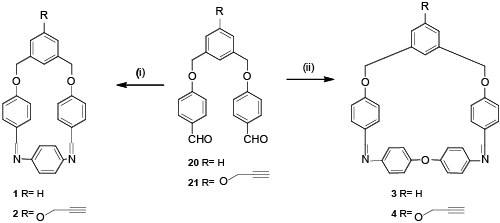
Scheme 2: Reagents and Conditions: (i) Benzene 1,4 diamine (1 eq), EtOH, Reflux, 4-6 h, 1 (64%), 2 (62%) (ii) / 4,4'-oxydianiline (1 eq), EtOH, Reflux, 4-6 h,3 (58%), 4 (54%)
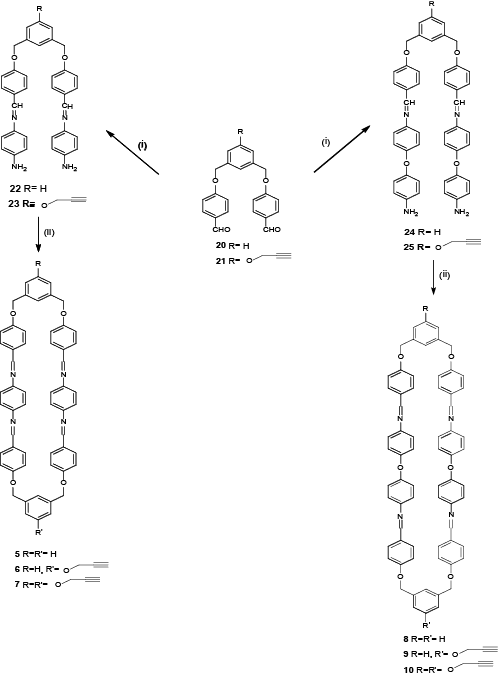
Scheme 3: Reagents and conditions: (i) Benzene 1,4 diamine (2 eq)/ 4,4'-oxydianiline (2 eq), EtOH, Reflux, 4-6 h, (ii) 20/21 (1 eq), EtOH, Reflux, 4-6 h.
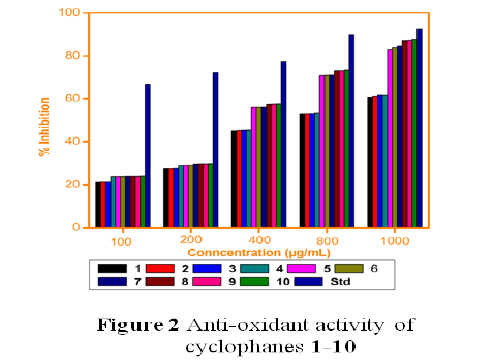
Figure 2: Anti-oxidant activity of cyclophanes 1-10
In the 1H NMR spectrum 5 displayed the methylene protons at δ 5.18 in addition to the signals for the other aromatic protons from δ 6.19 to δ 8.62. In 13C NMR spectrum 5 the methylene carbon appeared at δ 70.9 in addition to signals for the other aromatic carbons. The structure of precyclophanes 6-10 was also confirmed from the spectral and analytical data.
The DPPH (1,1-diphenyl 2-picryl hydrazide) radical scavenging assay [7] is an easy, rapid and sensitive method to screen the antioxidant properties of the synthesized dendrimers. DPPH scavenging assay reveals that the tetra dendate cyclophanes 5-10 shows better antioxidant property than the bidendate cyclophanes 1-4 (Figure 2). Figure 2 clearly indicates that the free radical scavenging property as measured by the DPPH method showed that percentage inhibition increases with increase in the number of imine linkages. In comparison with the results of standard ascorbic acid (DPPH for ascorbic acid is 92.71%), the antioxidant activities of the cyclophanes 5-10 exhibited significant radical scavenging property. The antioxidant activity of the cyclophanes increases from the bidendate to tetradendate cyclophanes which may be due to the presence of more number of imine linkages.
Cyclophanes with imine bond viz., iminophanes were synthesized by ether linkage and imine bond formation in good yields. All the synthesized iminophanes were subjected to in-vitro antioxidant activity by DPPH radical scavenging method and the results reveals that the tetra dendate iminophanes exhibits better antioxidant activities than the bibendate iminophanes in comparison with the standard ascorbic acid.
The authors acknowledge the DST-FIST, New Delhi for providing NMR facilities to the Department of Organic Chemistry, University of Madras and the Department of Faculty of Pharmacy for in-vitro antioxidant studies.
Download Provisional PDF Here
Aritcle Type: Research Article
Citation: Jayanthi M, Rajakumar P (2015) Synthesis of Bi- and Tetra- Dentate Iminophanes with Antioxidant Properties. J Nanomed Nanosurg 1(2): doi http://dx.doi.org/10.16966/2470-3206.104
Copyright: © 2015 Jayanthi M, et al. This is an open-access article distributed under the terms of the Creative Commons Attribution License, which permits unrestricted use, distribution, and reproduction in any medium, provided the original author and source are credited.
Publication history:
All Sci Forschen Journals are Open Access